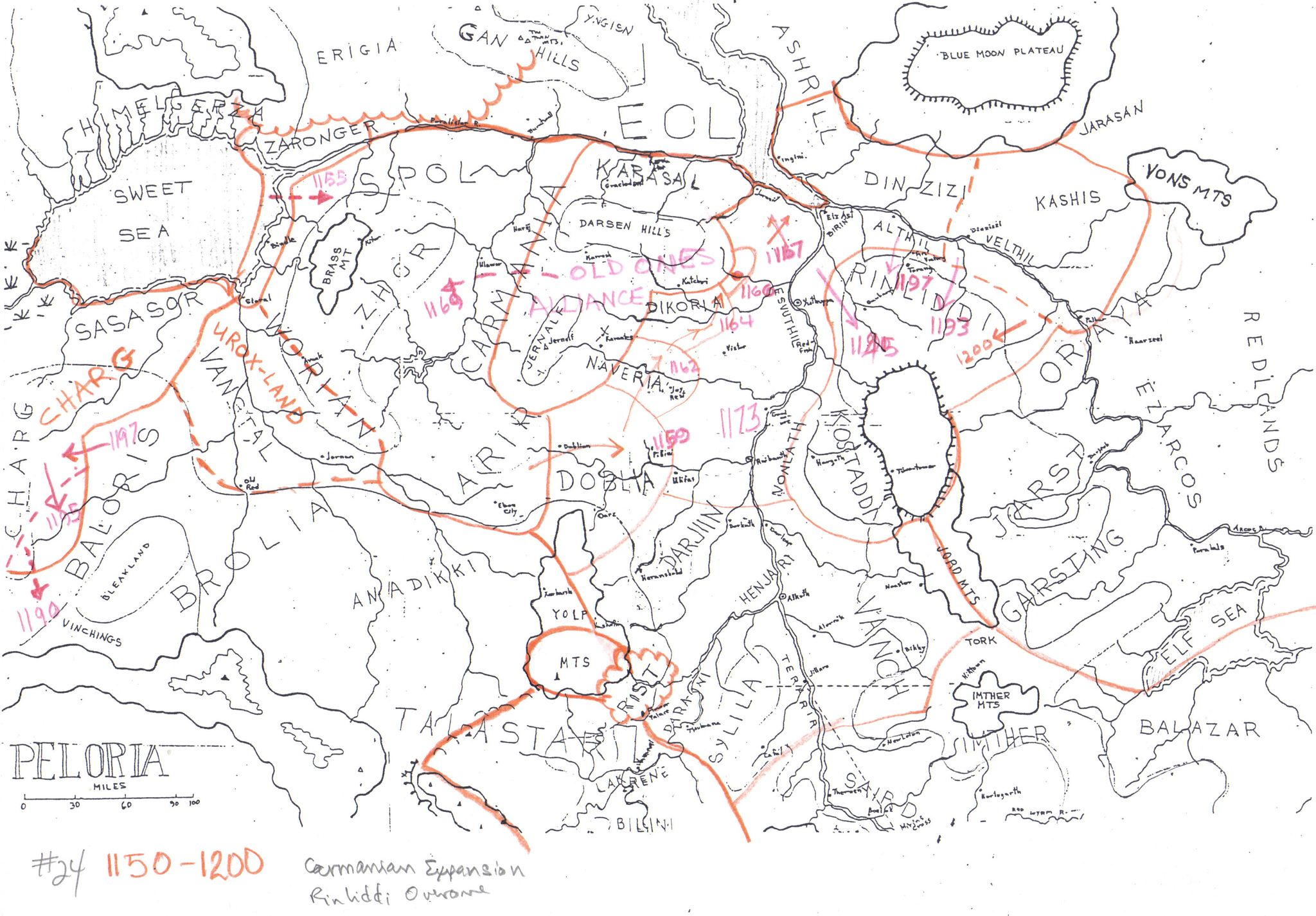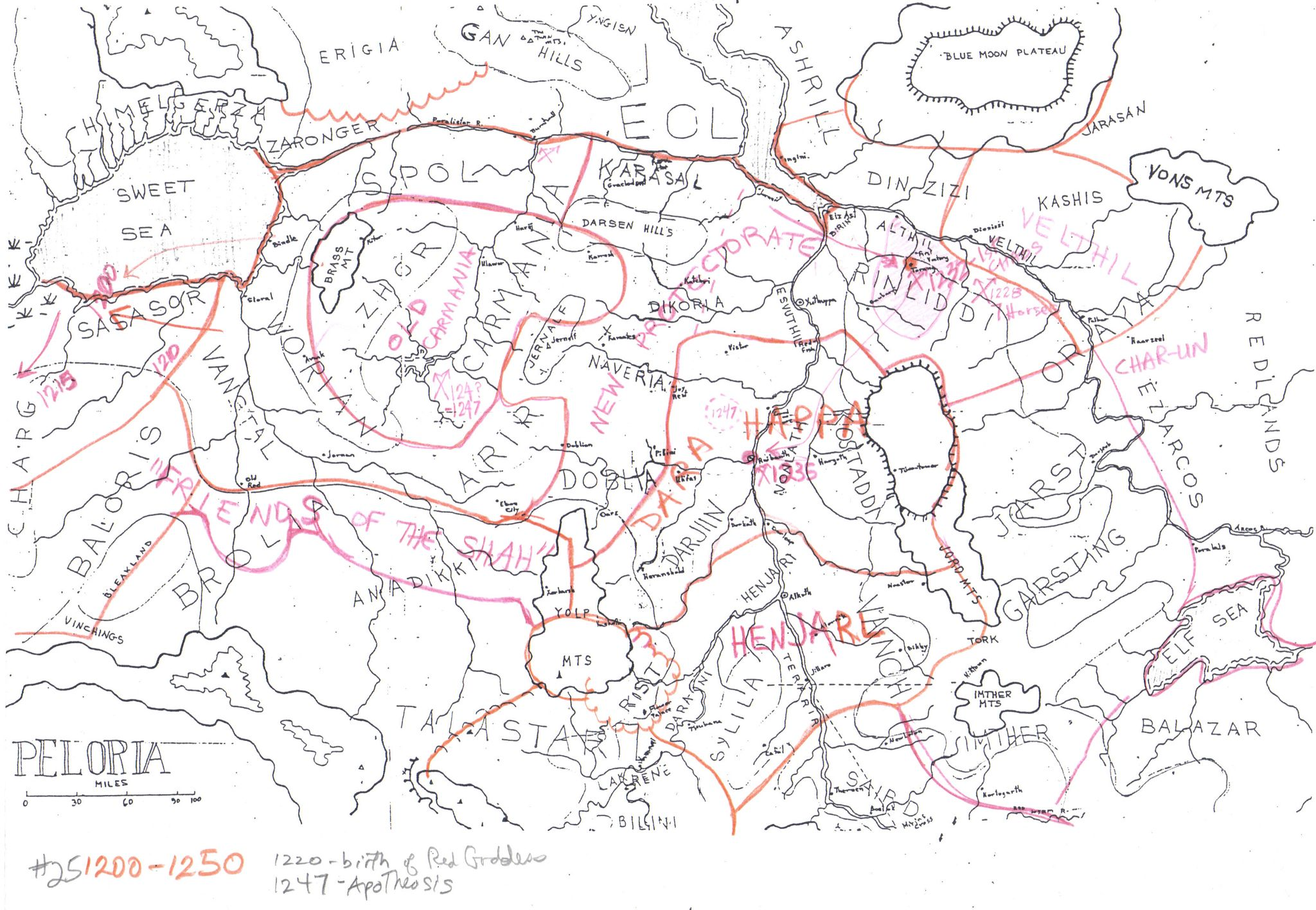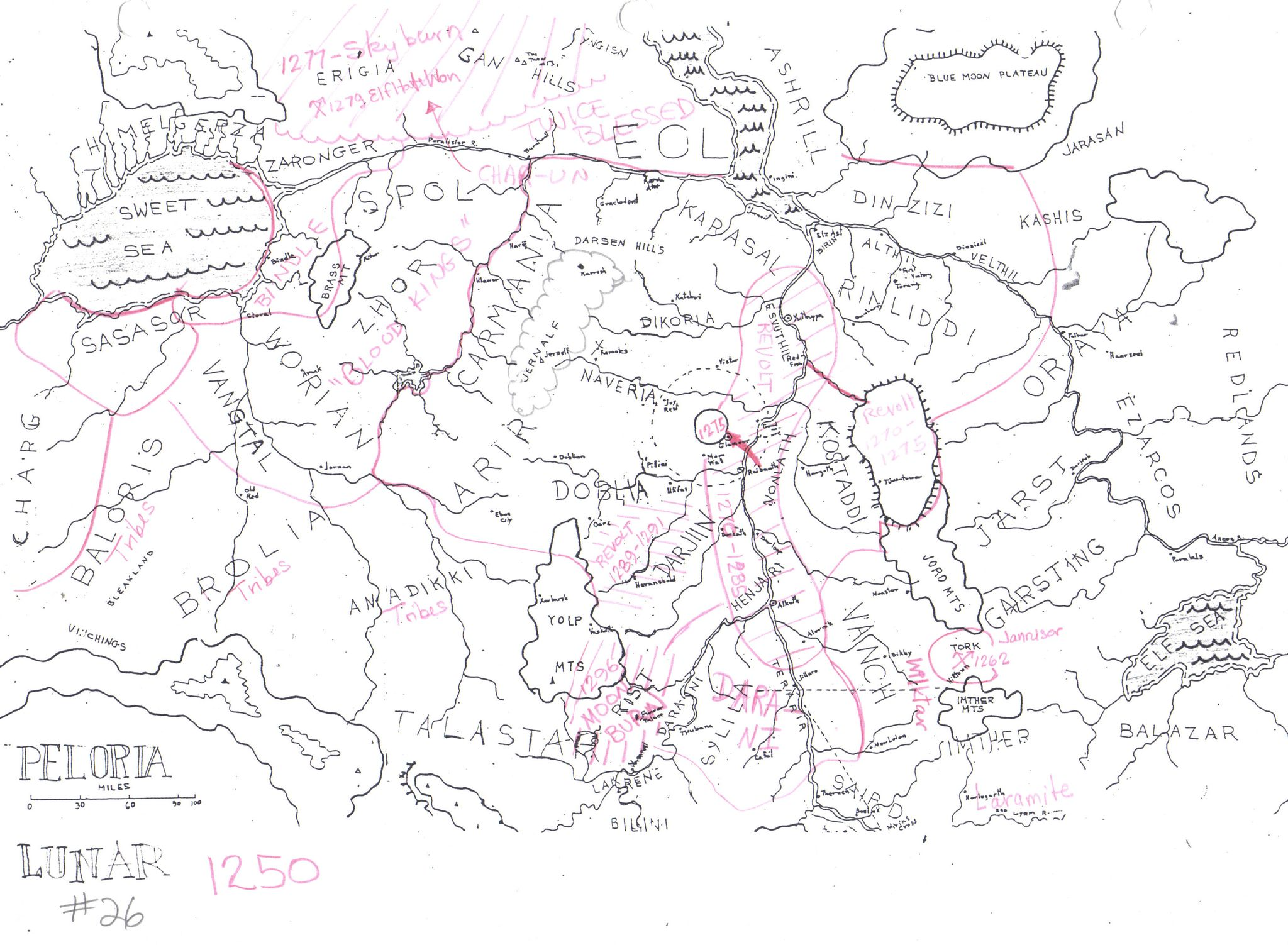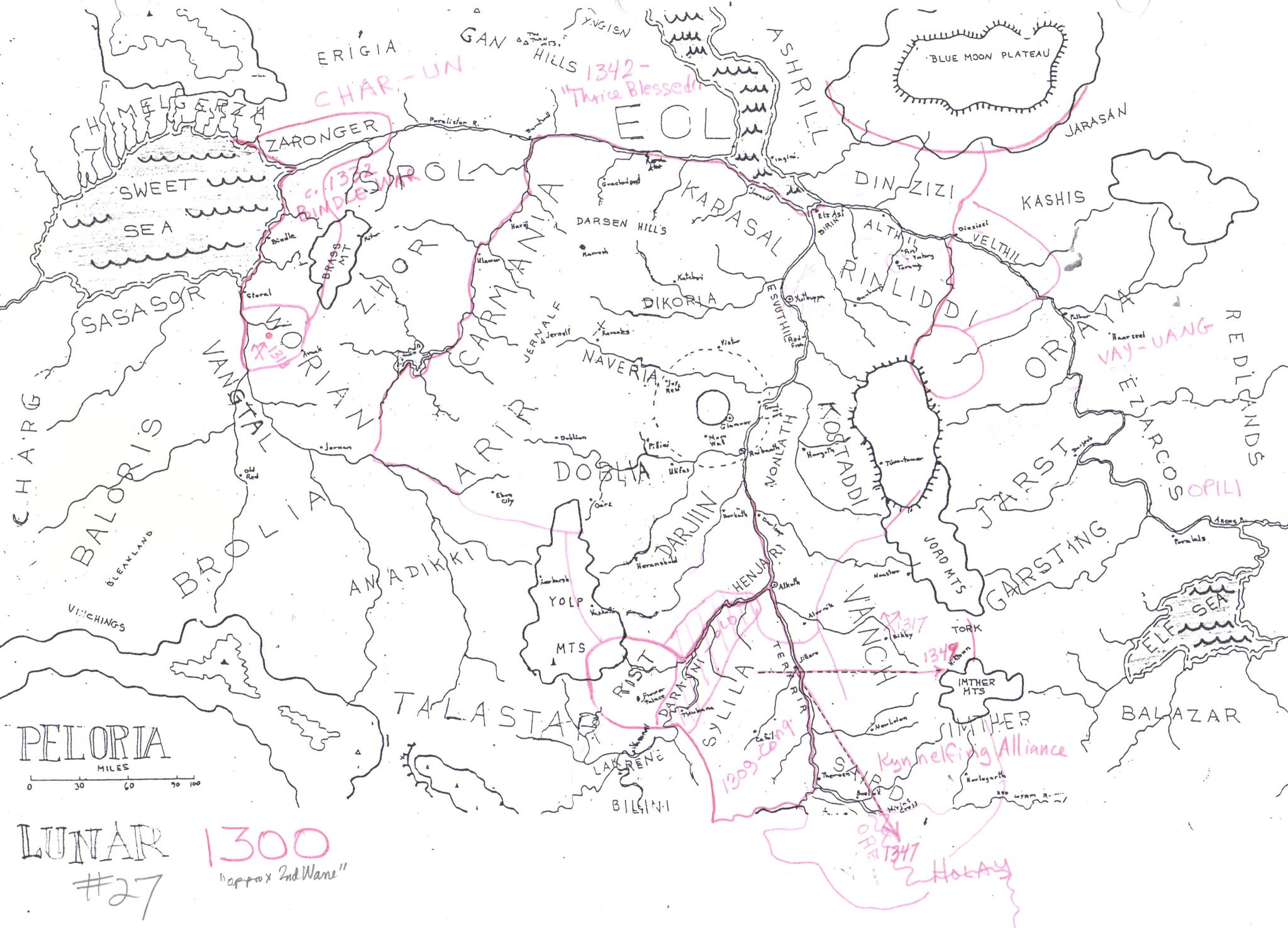Let’s talk a little bit about the south Pelorian Orlanthi, as I think that they are important as a background – even though the Lunar Tarshites are not merely a Lunarized variant of them, like describing the indigenous Bactrians before we talk about Hellenistic Bactria.
So see this series of maps – the areas of Lakrene, Saird, and the Vanch-Imther hills are our south Pelorian Orlanth homeland. The common folk here worshiped Ernalda, Orlanth Rex and Orlanth Thunderous, and the Lightbringers, and Yelmalio. The “savage but heroic” rulers worshiped Yelm and the sky gods, alongside the Lightbringers. They emphasized the Yelm and Orlanth rivalry – the rivalry between clouds and sun.
In short they were Orlanthi who had centuries of interaction with Dara Happa and had created a syncretic “God Learner” mythology – just like what we see in Cults of Prax. Orlanth Rex is the King of the Gods, Yelm is the Emperor.
Then we get the Dragonkill War. Everything past the Deadline is forbidden. That means the Orlanthi lands are basically Holay, Vanch, Imther, Aggar, and Talastar (Brolia etc are not worth talking about here). Pre-existing confederations collapse and Yelm gets defeated by the Carmanians. Yelmalio ends up being the main solar god in Saird and a rival of Alkoth’s Shargarsh, who rules a small empire in Henjarl.
But the Orlanthi are in contact with the rest of Peloria – they trade with them, they get their luxury goods there, and their symbols of status. The Orlanthi are poorer both materially and culturally than they were before the Dragonkill War – they are a rump of what they had been. I imagine they sell grain and livestock to the lowlands, plus other raw materials.
They also fight in the lowlanders wars. Many Orlanthi fought for and against the Red Goddess. And when Dara Happa revolted against the Red Emperor, an Orlanthi leader, Jannisor, brought an army of Orlanthi and other barbarians to sack Glamour. This was a very near run thing for the Lunar Empire, and after the revolt is finally defeated in 1285, the Red Emperor sends his Conquering Daughter to secure the south.
In about 40 years, she conquers Syllila, Vanch, Saird, and Imther. The Kynnelfing Alliance – the main Orlanthi tribal confederation – is defeated and the Daughter’s Road goes within 30 mile of the Deathline. Many Orlanthi flee Syllila, Saird, and Vanch and settle in Dragon Pass – especially those that were on the frontline against the Lunar Empire in the Dara Happan Revolt or against the Conquering Daughter.
Now already by 1350, I can see some big differences with these Orlanthi and those of the Holy Country. Yelmalio is already in their pantheon, and they know Yelm well (and have been ruled by him on many occasions, and not always badly). But Orlanth Rex is the king of the gods, and has the ability to impose his authority over the feuding clans. They have centuries of contact with Dara Happa. And they know the Lunar Empire. They were there when Jannisor shattered the gates of Glamour and when the Antelope People betrayed him. They saw the Moonburn. And witnessed the Conquering Daughter in action.
The settlements in Dragon Pass are many, although that around Bagnot – the Tarsh Tribe – is the largest and most important. In 1362 – just 15 years after the Daughter’s Road campaign, the Lunars march south again. But this time it is very different. Arim of Tarsh has allied with the ancient powers of Dragon Pass and the Twins call upon Maran Gor and wipe out the Lunar Army at the Battle of Falling Hills. The Tarsh Tribe of Dragon Pass is left alone for the time being. And within a generation, the Lunar Empire has much bigger problems – in 1375 Sheng Seleris crosses the Arcos River and invades Peloria. The Tarsh Tribe of Bagnot becomes the Kingdom of Tarsh and for nearly a century, Holay is largely abandoned to the Tarshites.
The Kingdom of Tarsh likely began as a confederation of tribes under the suzerainty of the Tarsh Tribe. The Danbalings of Kordros Island, the Barnteri between the Oslir and the Black Eel, the Alda-Chur of Far Point, and the Karvenings around Slavewall, all were ruled by the Tarsh Tribe, which extended from the Falling Hills to Kero Fin. The Uiteros and Quivini tribal groups were rebellious tributaries. The Grazelanders are initially close allies, and later enemies after the Tarsh King steals their sacred horses to create his own cavalry force loyal to him (the origins of the Pol-Joni). The Praxians and trolls are sometimes hired as mercenaries.
So taking a snapshot, around 1450, the Tarshites are a powerful barbarian kingdom. They dominate Dragon Pass, but I do not think they are particularly rich. There isn’t that much trade between the Holy Country and Peloria – Sheng Seleris is too disruptive for that. The Tarshites are recognizably Orlanthi, although some lowlander cults are likely well-known – Oslira, Yelm, Lodril, maybe even Dendara (although Ernalda is the main goddess). The Earth cults are VERY important, and Maran Gor and Babeester Gor are an important part of the kingdom’s strength, but also demand human sacrifice. But they also have Orlanth Rex, Humakt, and the other Lightbringers. Storm Bull, Eiritha, and Waha are not significant, while the conflict between Orlanth and Yelm gets played out in war with Pentans and Pure Horse People (as well as Dara Happans).







![]()
![]()
Map #22 is useful as it shows “Dara Happan” Saird. A member of the ruling house of Carmania and Dara Happa was assigned an army and conquered Saird from the EWF. He established a dynasty that appeared to stay out of the conflict between the Carmanian and Dara Happan branches of the family (in what is called 3 Generations of War). It also shows Balazar heading off to found his kingdom.
Map #23 Saird suffered terribly in the Dragonkill, being closest to Dragon Pass. The Dara Happan empire invaded Saird, and the kingdom pretty much collapsed.
Meanwhile the Uroxi Bull Shahs seized power in Carmania.
This marks the end of the great dynasty that once held Carmania, Dara Happa, and Saird.
Map #24 By now Saird and Southern Peloria are impoverished backwaters. Henjarl rules over Sylila, Darwin, and Ranch, and the Kingdom of Talastar unites Lakrene and the Bilini.
Map #25 At the time of the Red Goddess, southern Peloria was even more of a backwater. Henjarl (aka Alkoth) was the main power in southern Peloria, with Talastar as another major political entity.
Map #26 During the Dara Happan Revolt of 1270-1285, the barbarians of South Peloria (Vanch, Imther, Dara-Ni, and Saird) and the Antelope Riders aided their traditional Dara Happan foes against the new Lunar Empire. In 1275, the barbarian Hero Jannisor reached the inner gates of Glamour, before he was betrayed by his Antelope Rider allies. After that terrible defeat, the barbarians withdrew from the revolt, which continued on for another decade.
Map #27 About a generation after the Dara Happan Revolt was finally ended, the Conquering Daughter began her campaigns in South Peloria. Over the next half-century, various barbarian confederations were conquered or otherwise defeated by the Conquering Daughter, providing stability and security to the Lunar Empire’s southern flank. No doubt Jannisor’s nearly successful campaign in 1275 was a major impetus.
An interesting factoid – the Daughter’s Road from Jillaro to Filichet nicely lines up with Kero Fin!
